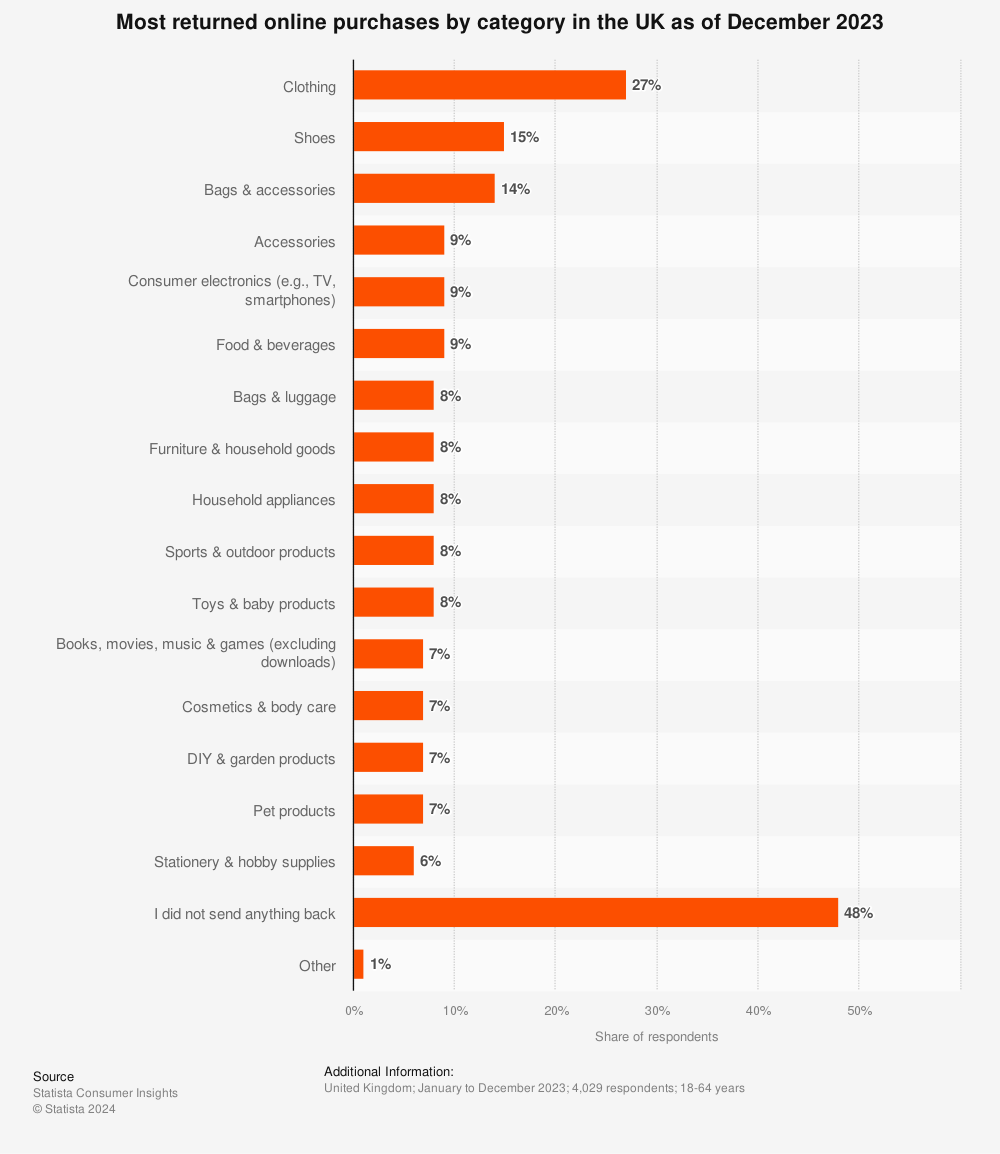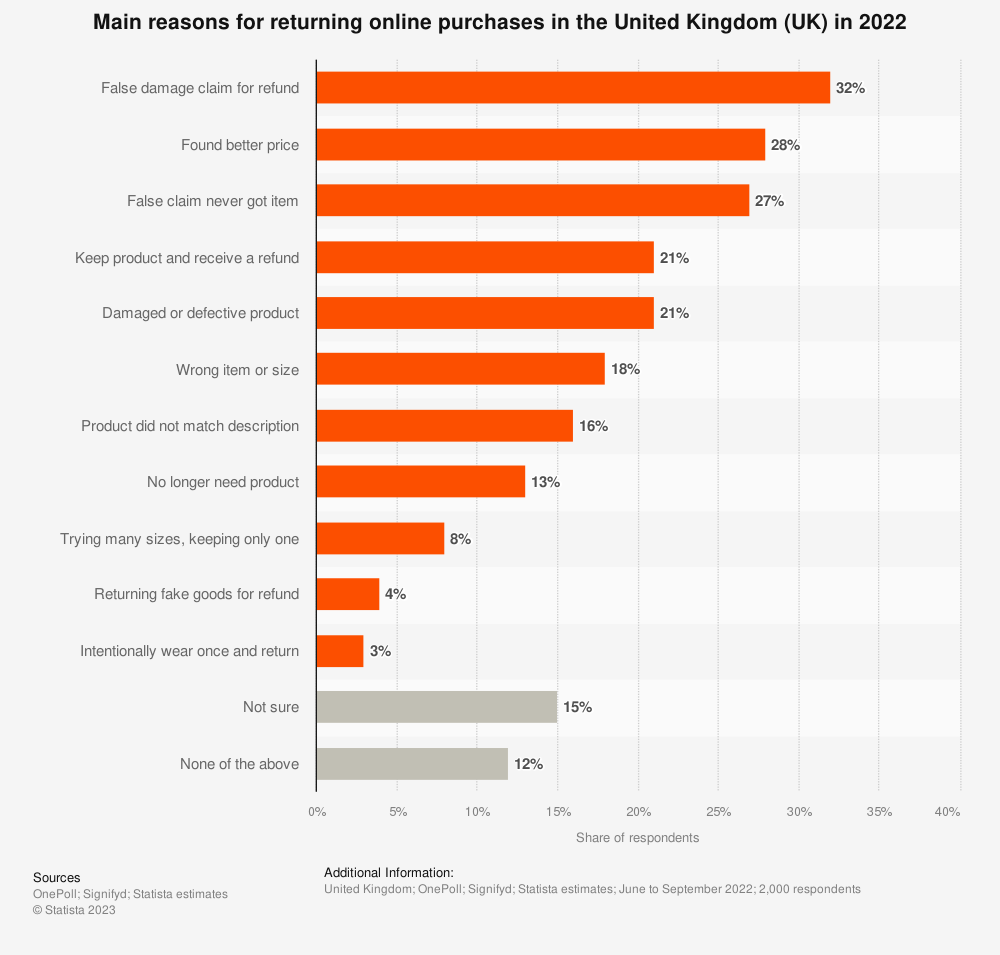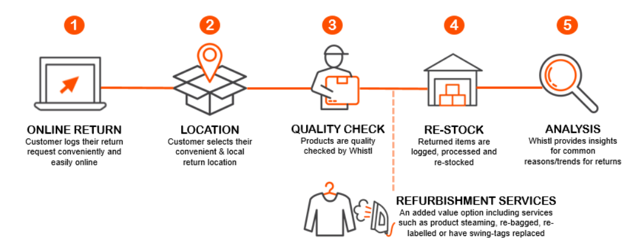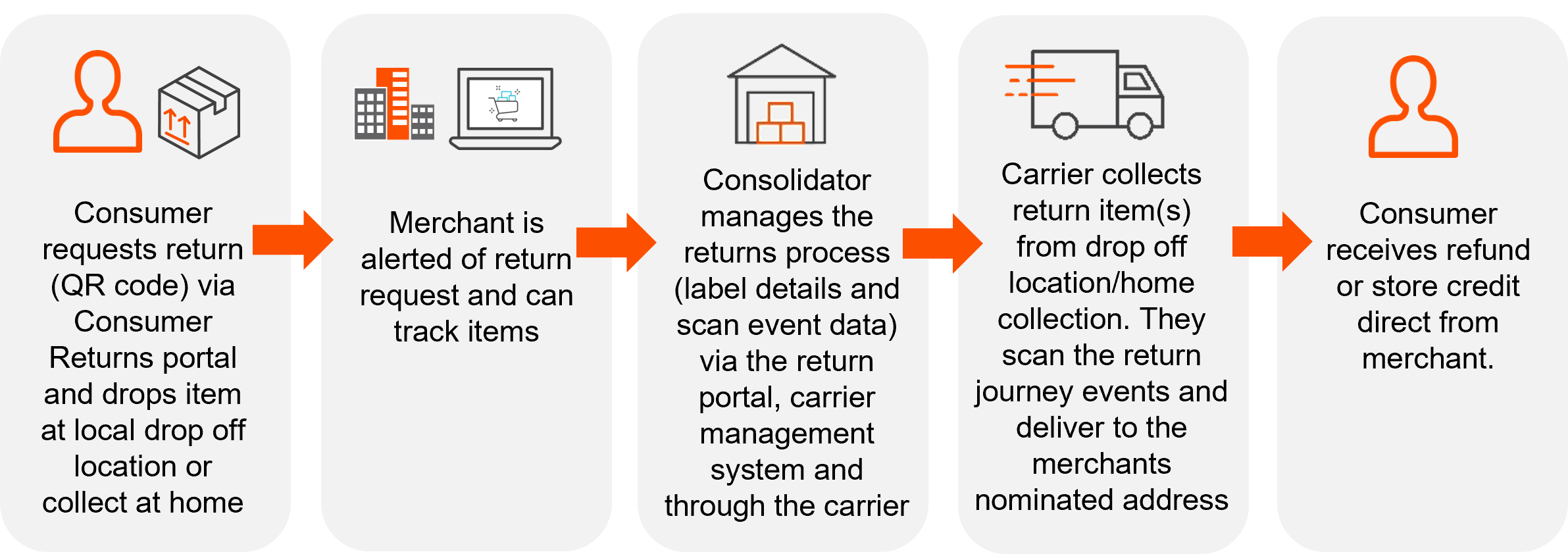eCommerce Returns: UK Consumer Trends and Best Practice
The rise in eCommerce returns shows no sign of slowing down as both consumers and retailers prioritise hassle-free shopping experiences. Customers expect online returns to be at no or low-cost and as seamless as possible.
Meanwhile, eCommerce businesses find themselves working harder than ever to streamline their returns management processes and minimise the cost of returns.
Reports suggest one in three online purchases are being returned. This compares to 9% of in-store purchases and adds up to a costly and time-consuming challenge.
This updated eCommerce Returns research plots the current state of play. And provides eCommerce leaders with best practice advice on how to save time and money alongside simplifying consumer returns.
Table of Contents
The growth of the reverse logistics market
Reverse logistics’ (returns) is a huge business. We’re returning more items than ever and the worldwide market is expected to be worth $954.5bn by 2029. This would represent an increase of over $250bn from 2023 levels.

Managing this drastic increase is no easy feat when you’re also trying to achieve eCommerce growth. For online retailers, returns represent lost sales and an added cost to retrieve and re-stock items.
While figures fluctuate it’s estimated that consumer returns are costing UK retailers a staggering £60bn per year with eCommerce stores particularly affected. Online parcel returns typically cost £3 more compared to in-store returns with some reports suggesting the process of returning an item can cost up to twice as much as it does to deliver it.
However, retailers are starting to take a proactive approach to juggling the delicate balancing act between managing costs while exceeding consumer expections.
Here’s four of the top focus areas in returns management:
1. Greater control, greater flexibility. Savvy online retailers are getting smart about their returns options. Rather than give immediate refunds, some are offering item exchanges or store credit. Meanwhile, others are dialling up and down the cost of returns or providing annual subscription costs for returns.
2. Easy-to-use returns platforms. Technology plays a crucial role in the modern returns process and having an easy-to-use returns platform is a must for ensuring customer satisfaction. End-to-end parcel returns processes have become readily available via integrators and consolidators
3. Spotlight on sustainability. A greater focus on sustainability is one of the key emerging trends in the returns space. Expect more companies to focus on reducing waste, recycling materials and cutting carbon emissions as the reverse logistics industry tackles its biggest challenge.
4. Omnichannel as a secret weapon. The line between online and in-store retail has become even more blurred. While the Covid-19 pandemic resulted in an online boom, consumers have since returned to bricks and mortar stores. Shoppers have become accustomed to this blend and the ability to return items through multiple channels could become a key differentiator.

eCommerce returns statistics
The trend of UK eCommerce returns
The UK is a nation of serial returners with 71% of online shoppers returning items at varying frequencies. eCommerce returns pose unique challenges compared to in-store.
Items returned in-store can be quickly examined and placed back on sale. However, eCommerce retailers do not have the same levels of visibility or certainty. Tracking for returns is often not as robust as it is for the initial dispatch. Meanwhile, online retailers also face the uncertainty of not knowing whether items are being returned for honest reasons or what condition they’ll be returned in. 
What items are we returning and why?
The fashion industry is the biggest contributor to eCommerce return rates. Clothing (27%), Shoes (15%) and Bags and Accessories (14%) are the most returned items by UK consumers, with Clothing items topping many lists across the globe.

The volume of returns is challenging. However, the latest reasons for returning online purchases further outlines the issues encountered by eCommerce retailers. A 2023 survey by Onepoll/Signifyd found that nearly a third of shoppers had made false damage and refund claims (32%). A sizeable 28% had returned items because they’d found a better price while 27% had falsely claimed they’d never received their item.
The reasons highlighted mark a shift from more traditional grumbles about items not being the correct fit or arriving in poor condition. You must go further down the recent list to find reasons such as ‘damaged or defective product’, ‘wrong item or size’ and ‘product did not match description’.

“Buy, Try, Return” has increased since the pandemic
Alongside the rise in returns, ‘Buy, Try, Return’ has become a more frequent habit amongst online shoppers. Younger shoppers already felt comfortable enough to "buy, try, return". But since the pandemic this has also become learned behaviour for older customers :
● 38% of all UK online shoppers said they now feel more confident in returning online purchases.
● 49% of UK online shoppers have returned goods back in the past year, rising to 60% for 16-34-year olds.
UK consumer expectations
Our own eCommerce Consumer Research revealed that almost two-thirds (65%) of UK online shoppers expect returns to be free under any circumstance. Only 3% said that “it is reasonable to expect the customer to pay for the return.
However, if no free option is offered, the research found that 48% of those who shop online weekly or more often would be willing to pay a £20 annual fee to return items.

eCommerce returns behaviour
Analysis from Statista highlights that in 2023, the average cost of returning an online purchase to leading retailers in the UK was £13.10. The average cost decreases to £3.19 for fashion items.
For retailers, weighing up the cost of returns against consumer expectations is a delicate balancing act. UK consumers are willing to pay up to £6.80 to return items valued at £150. This falls to £4.70 for orders worth £15.
The traditional Post Office is the most preferred returns destination amongst all age groups, with 42% of eCommerce consumers opting for this method. Home pick-up (39%) is also gaining in popularity, although this is only currently offered by 6% of all UK retailers.
Sustainability is another issue that’s become top of mind. The RetailX Sustainability Report 2023 found that 74% of consumers want retailers to be more sustainable.
The report also revealed that 57% of global respondents ‘strongly agree’ or ‘somewhat agree’ they’d be willing to pay more for products if they knew they were produced and transported in a way that didn’t harm the environment.
Ultimately, retailers that view sustainability as an opportunity and not a challenge will likely capture the attention of consumers.
Best practice for managing eCommerce returns
Despite challenges, enhanced technology and processes give retailers reasons to be optimistic. By adopting new systems and ways of working it’s possible to reduce the number of returns while boosting revenue and customer satisfaction.
Effective ways to reduce eCommerce returns
Aligning operational and customer service teams can make a crucial difference to the customer experience. You may have your own dedicated in-house teams or this could be outsourced to a partner with greater expertise.
Understanding reasons for returns
Learning from your returns data enables you to understand why customers may be returning products and make better decisions in the future. A review of your supply chain will help to limit the number of ‘common returns’, including:
- Broken/faulty product.
- Wrong size sent.
- Arrived late.
- Item does not match description.
Review supply chain inefficiencies
Addressing inefficiencies within your supply chain can improve your returns process. A few of the areas of your returns supply chain that should be reviewed include:
1. Inventory Management
- Ensuring re-saleable items are added back as ‘in stock’ within your inventory management system, in real-time.
- Implementing a refurbishment process that adds items back to ‘in stock’ once any necessary cleaning/repairs have taken place.
- Prioritising swift and efficient refunds to meet customer expectations and facilitate future purchase opportunities.
2. Pick and pack
Pick and pack is the process of accurate and efficient product and packaging selection from correctly referenced locations. Doing so will minimise damages in transit and limit the chances of customers receiving the wrong item. It should include:
- Regular packing and item inspections.
- Use of protective packing material where needed.
- Addition of Fragile labels for parcels with delicate items.
- Use of outer parcels that ensure a ‘correct fit’ without unnecessary movement.
3. Despatch
Work with fulfilment specialists or third-party logistics partners focused on eCommerce to ensure smooth delivery and minimised damages in transit. Specialist fulfilment and parcel delivery management companies like Whistl offer:
- Complete account management of all processes.
- Choice of delivery partners/carriers.
- Cost-efficient rates through consolidated volume and buying power.
- Late cut-off times for carrier collections.
4. Customer Service
The customer is at the centre of your revenue opportunity, therefore relevant customer service support is vital.
In-house or third-party contact centre specialists should have access to relevant information to advise the customer of the order or return status.
Ways to manage returns
For eCommerce retailers, the way you manage returns could be dependent on whether you have offline and online destinations, the type of items you sell, or the volume of returns you typically expect to handle.
Return to store
If you have a physical store then this is a convenient and popular choice for all parties. It allows retailers to inspect items and deal with any issues promptly. Meanwhile, customers can have refunds issued in-person and browse more of your stock while returning items. This can encourage other purchases while in-store.
Outsource to a 3PL provider (Fulfillment solution)
Returns management can be added as part of a fulfillment process. The appointed Third-Party Logistics (3PL) partner ensures:
- Return reasons are properly logged and assigned to each item.
- Items are inspected for any damages.
- Items are refurbished or repaired where possible.
- Saleable items are added as ‘in stock’ to your inventory and placed back in their pick location for resale.
- Customer refunds are processed efficiently.

Having a returns policy that aims to retrieve your items in a sellable condition is important to avoid lost profits. This can be key for electronic, apparel and home furnishing items, as inspections can take longer to process. Some fulfilment companies offer refurbishment services to rework and repair items to maximise saleable inventory. Examples include:
Outsource Returns Management (Consolidator platform solution)
The proliferation of returns management software means you don't have to look far to find a platform that can support your returns process. However, deciding which one to choose can create a separate logistical nightmare.
Consolidators such as Whistl bridge this gap by providing end-to-end, multi-carrier solutions that are hassle-free. By leveraging their own partners and integrations, a consolidator can streamline the returns process and offer a fully managed service.
Effortless consumer returns help:
- Drive up-selling opportunities.
- Improve customer satisfaction.
- Encourage repeat purchases.
E-commerce retailers exploring this option can expect:
- A customisable online portal.
- Ability to add photos to justify reason for return.
- Print in store option.
- Simple dashboard to manage all returns.
- Dynamic ‘Free’ or ‘Shipper Paid’ options based on returns reason.
- Analysis for merchant to understand consumer shopping behaviours.
- Management of the returned parcel journey through the carrier networks, providing real-time consumer and merchant notifications.
- Restricted ‘max’ usage of any Free of Charge return reason based on consumer email address.
- Paperless returns as standard.
Benefits to consumers:
- The consumer can see all tracking events once the item has been dropped off, including once it has been delivered.
- The consumer can also view all other information about their return, including estimate time for refund.
Benefits to e-commerce retailers:
- Full control and visibility of all returns in one place along with the ability to maintain and update your own portal.
Whistl's Consumer Returns process

Delight your customers with Consumer Returns by Whistl
Are you drowning in eCommerce returns and looking for a way to delight your customers at this crucial stage of the journey?
We’ve got the perfect solution.
Consumer Returns by Whistl gives your customers the ability to manage their returns through a simple dashboard.
Once a customer has booked their return via one of the options provided (drop-off location or collect at home), we then manage the process via our carrier partners.
Meanwhile, live scan events guarantee a seamless and visible journey, from collection through to return.
With Whistl Parcels you can boost profits and save time with our proactive, hassle-free, multi-carrier delivery solutions. You can easily reach your customers around the world with our International Parcel Delivery and customs clearance solution service.
Head to our Consumer Returns page to find out how we can simplify your process.
Last Updated: February 2024
Originally Published: May 2022

Contact us to find out more!
We'll help you find the right courier management software solutions for your business needs.
Call us
We'll call you
Complete our contact form